Gulls from a mixed German colony on the Dutch beach

“Wow, pretty awkward 1e cycle bird.”
From the early 80’s Caspian Gull showed a strong increase in breeding range(1), expanding westwards into the area of Herring Gull thus causing a hybrid zone. This contact started in central Poland along river Vistula and the water reservoir near Wloclawek. A decade later Herring Gulls in the lake district of Brandenburg, eastern Germany saw Caspians entering their grounds.
It is difficult to estimate the exact number of hybrids in these colonies; about 400 breeding hybrids for Poland were estimated for 2004 and the 2015 ringing session at Gräbendorfer See, Germany produced 250 ringed chicks, of which ”the majority was expected to be Caspian Gull, but a substantial number must have been hybrid juveniles”(2).
It remains difficult to label these ‘probable hybrid chicks’ with species names after ringing, as the breeding islands are too distant for monitoring the parent – chick interactions. Labelling the individual birds has to be done later, after fledging. So far, ring readings show that a good number of these German and Polish birds spend autumn and winter on the Dutch beaches (Van Dijk, 2013).
Both Poland and Germany have intensive ringing programmes in their mixed colonies. Observations and detailed documentation of these ringed birds, also in the Netherlands, may help to get a better understanding and ID of hybrid birds. Still, two points to consider:
I: pictures from Russia and Azerbaijan show a large intra-specific variation for Caspian Gulls (it is a gull after all), and this variation may be larger than fully understand at the moment in (western) Europe. Therefore, a suspect bird may very well be “just another Caspian” falling within the variation of pure Caspians.
II: hybridisation is an ongoing process for over decades already in Poland and Germany, resulting in mixed colonies containing many ‘back-crossings’. Hence, is it still possible to recognise a hybrid bird that is only 3/8th Herring Gull? And if so, what do you call this?
This short note includes images of several 1st cycle birds in autumn, which were present at Katwijk beach, the Netherlands in 2016. In general they resemble Caspian Gulls, but minor points diverge from the classic view in a way I expect mixed parents may have been involved.
Footnotes:
(1) Caspian Gull is a Polish breeding species since 1981. It showed an exceptionally high annual grow rate of 33% between 1997 and 2004. The breeding population was estimated to be 1100 pairs for 2009 (Beran, 2010 and Neubauer, 2006).
(2) Ronald Klein, pers. comm.
========
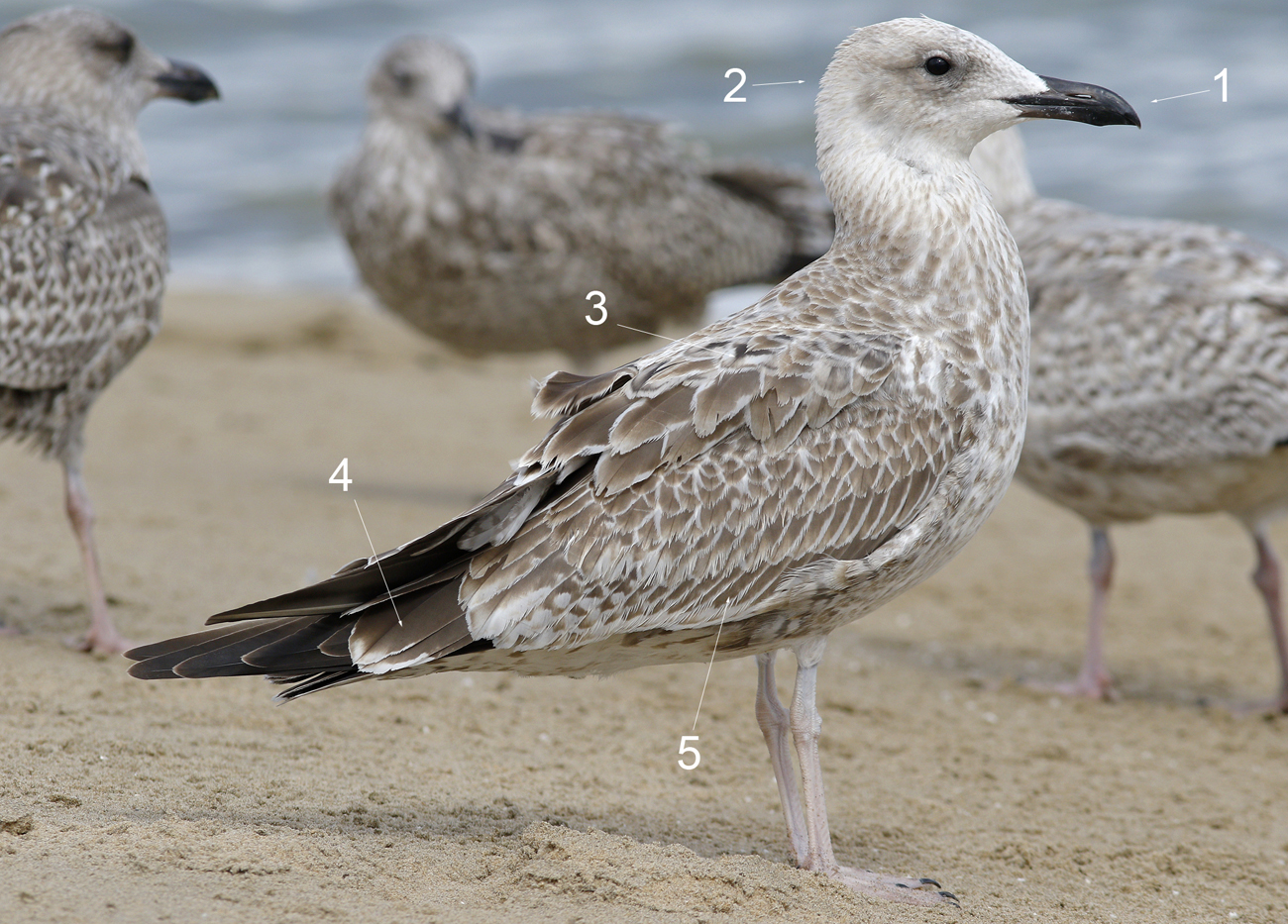
Plate A: Caspian Gull 1st cycle, August 29 2016, Katwijk. Surrounded by recently fledged (local) Herring Gulls, the differences between the species include: and obviously worn plumage by August, a long and slender bill (1), a pale head in late summer (2), replaced scapulars (3), no notching on the tertial fringes (4), and dark-centred greater coverts with rather straight pale fringes; no notched ‘postage stamp pattern’ (5).
This is a reference bird for late summer.
========

Plate B: Caspian Gull 1st cycle, September 02 2016, Katwijk. In the background several ‘fresh’ juvenile Herring Gulls. It is different in the long and slender bill (1), the white head in late summer (2), replaced scapulars (3), lack of notched pattern on tertials (4), dark-centred central greater coverts lacking obvious notching (5) and pale underparts (6).
========
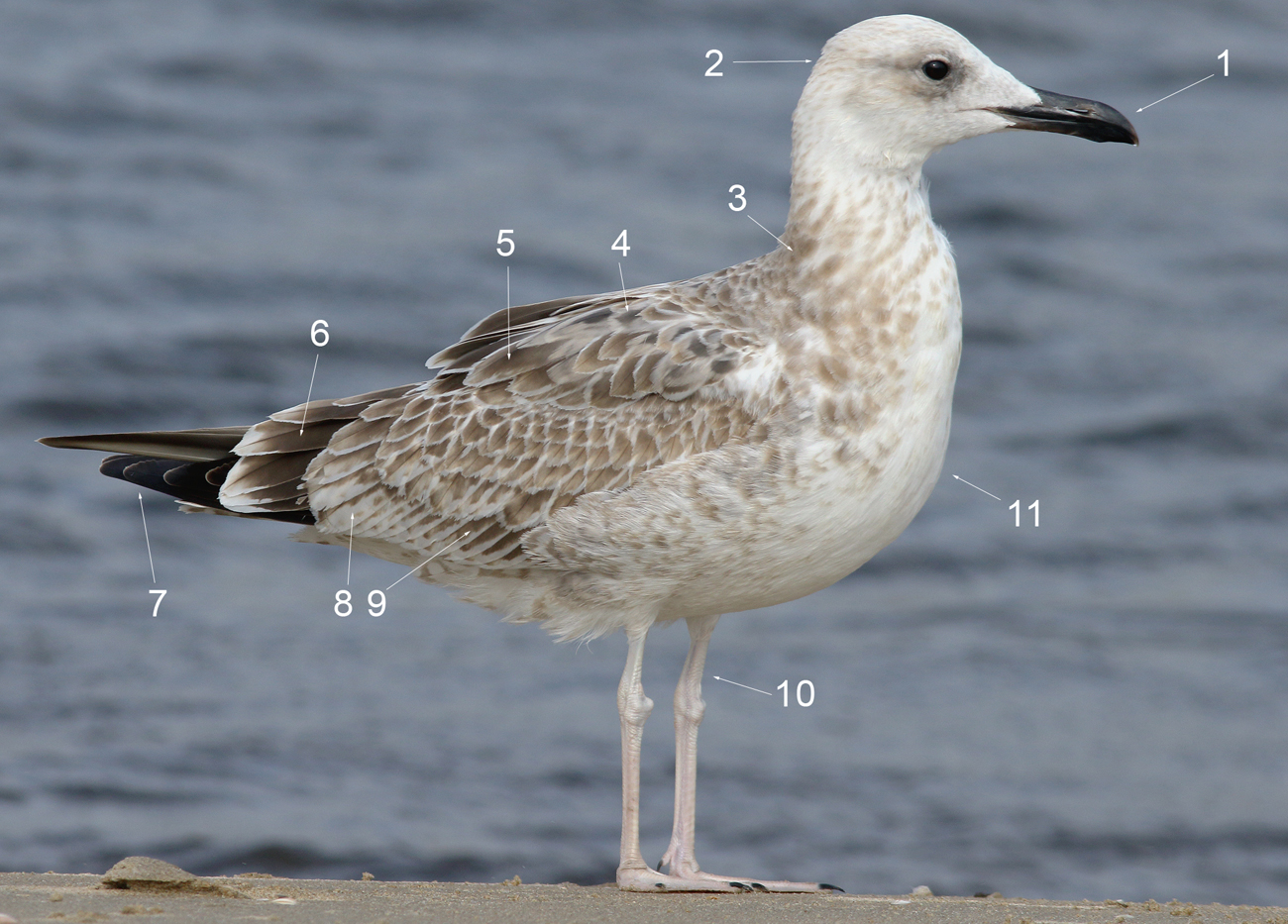
Plate C: Caspian Gull 1st cycle, September 06 2015, Katwijk. Classic bird showing a long slender bill (1), pear-shaped pale head on long looking neck (2), neck streaking concentrated in lower hindneck, like a ‘boa’ (3), the new scapulars are grey-based and dark-centred, lacking thick transversal bars (4; Herring Gull often show a bold anchor pattern), old juvenile scapulars hardly show any notching on the fringes (5), no notching on tertial fringes (6), blackish outer primaries lacking obvious white tip (7), the coverts are pale brown, the inner greater coverts have extensive pale tips (8), while outer greater coverts have rather straight pale fringes lacking notching (9), it has long looking thin legs as most of the tibia are visible (10), and finally, the underparts are predominantly white on breast and belly (11).
This is a reference bird for autumn.
========
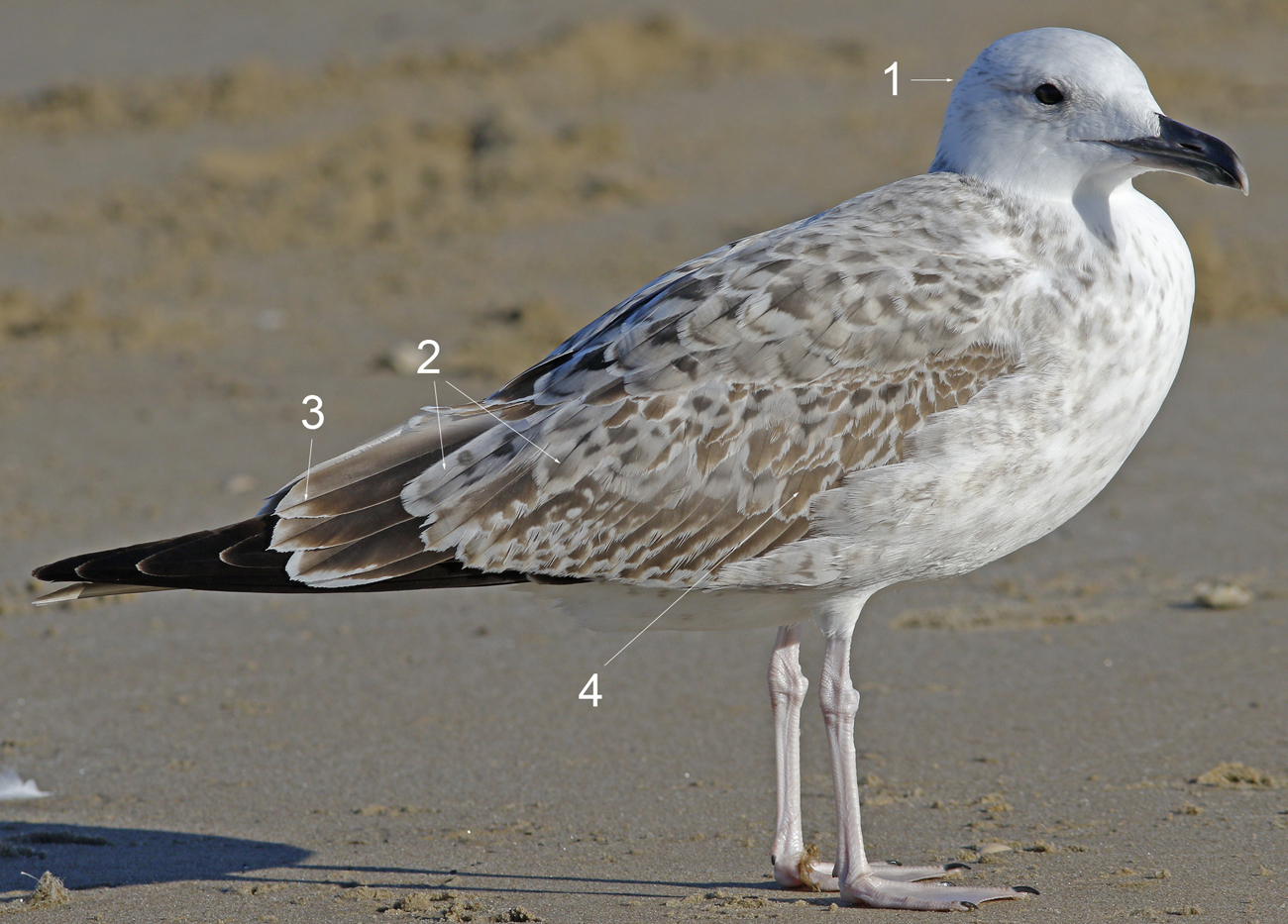
Plate D: Caspian Gull 1st cycle, October 05 2016, Katwijk. Classic bird showing white head and underparts (1), several replaced scapulars (2), no postage stamp pattern on tertials (3) and the juvenile wing-coverts have a pale brown, almost reddish brown tone (4).
========
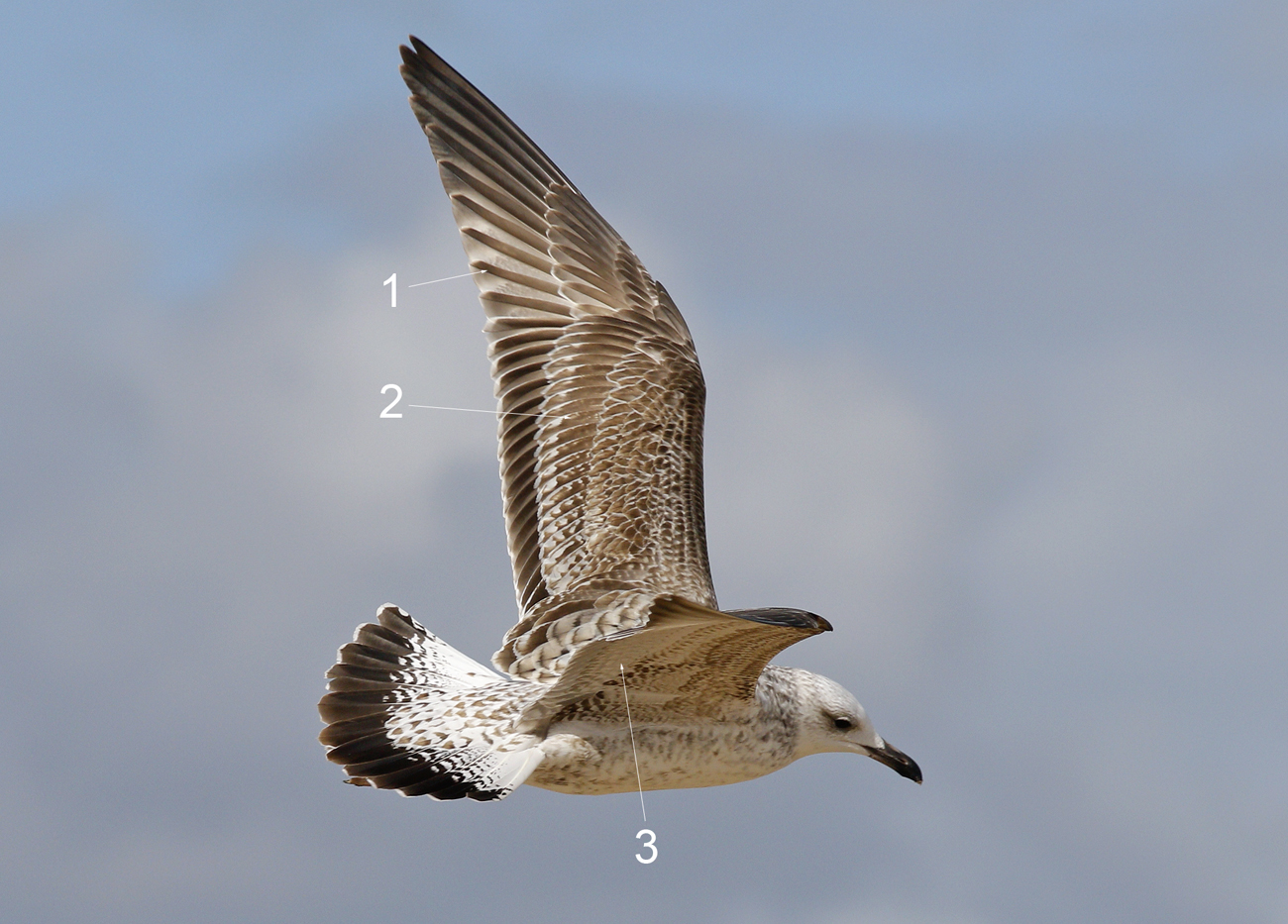
Plate E: Caspian Gull 1st cycle, October 03 2016, Katwijk. Classic pattern on upperwing with inner primaries showing dark outerwebs (1), dark-centred central greater coverts lacking notching on the fringes (2) and much of the underwing is pale (3).
========
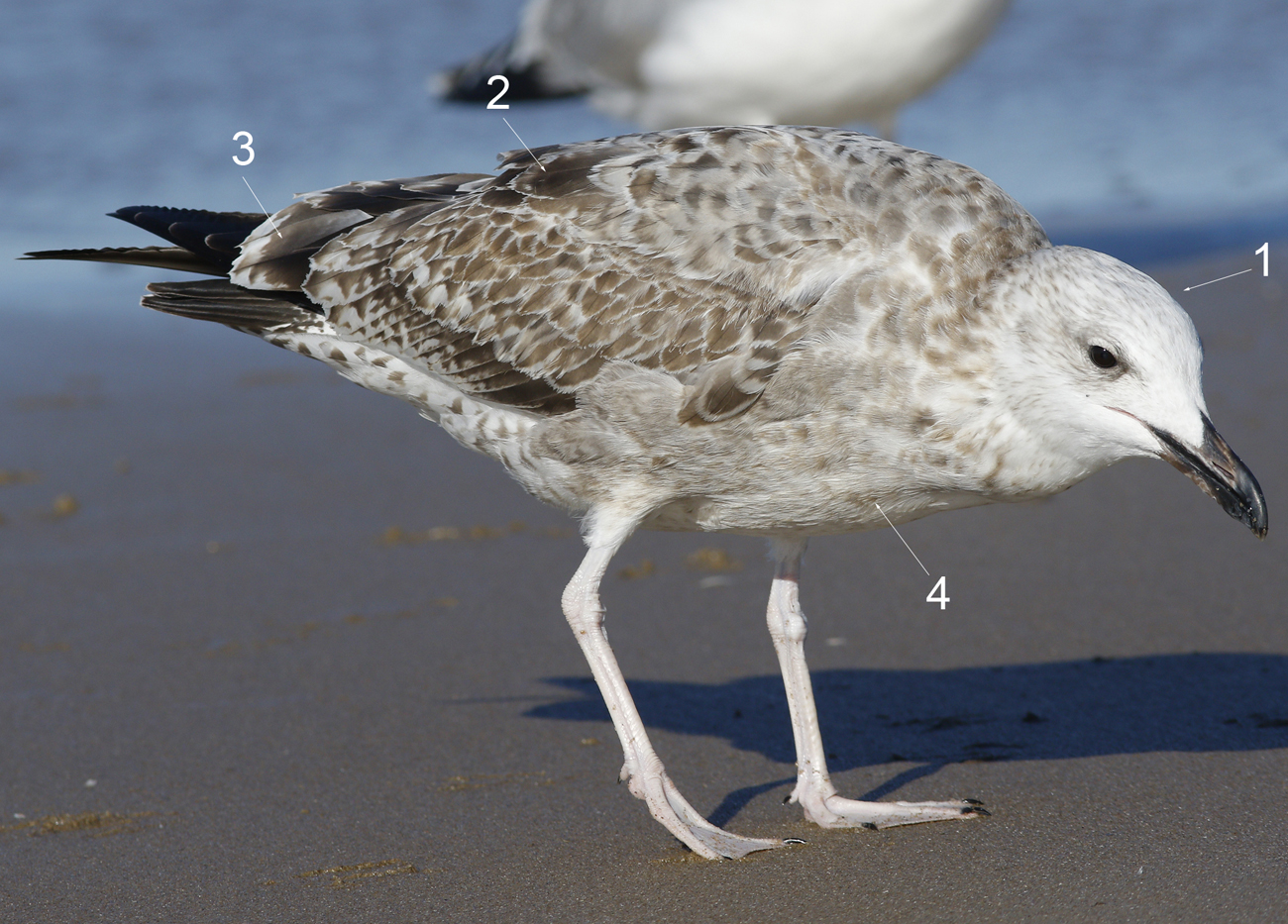
Plate F: Caspian Gull hybrid 1st cycle, October 05 2016, Katwijk. Superficially resembling Caspian Gull, but different in the angular head like in Herring Gull, with rather dense streaking (1), late scapular moult (2), obvious notching on tertial fringes (3) and irregular brown texture on underparts (4).
========
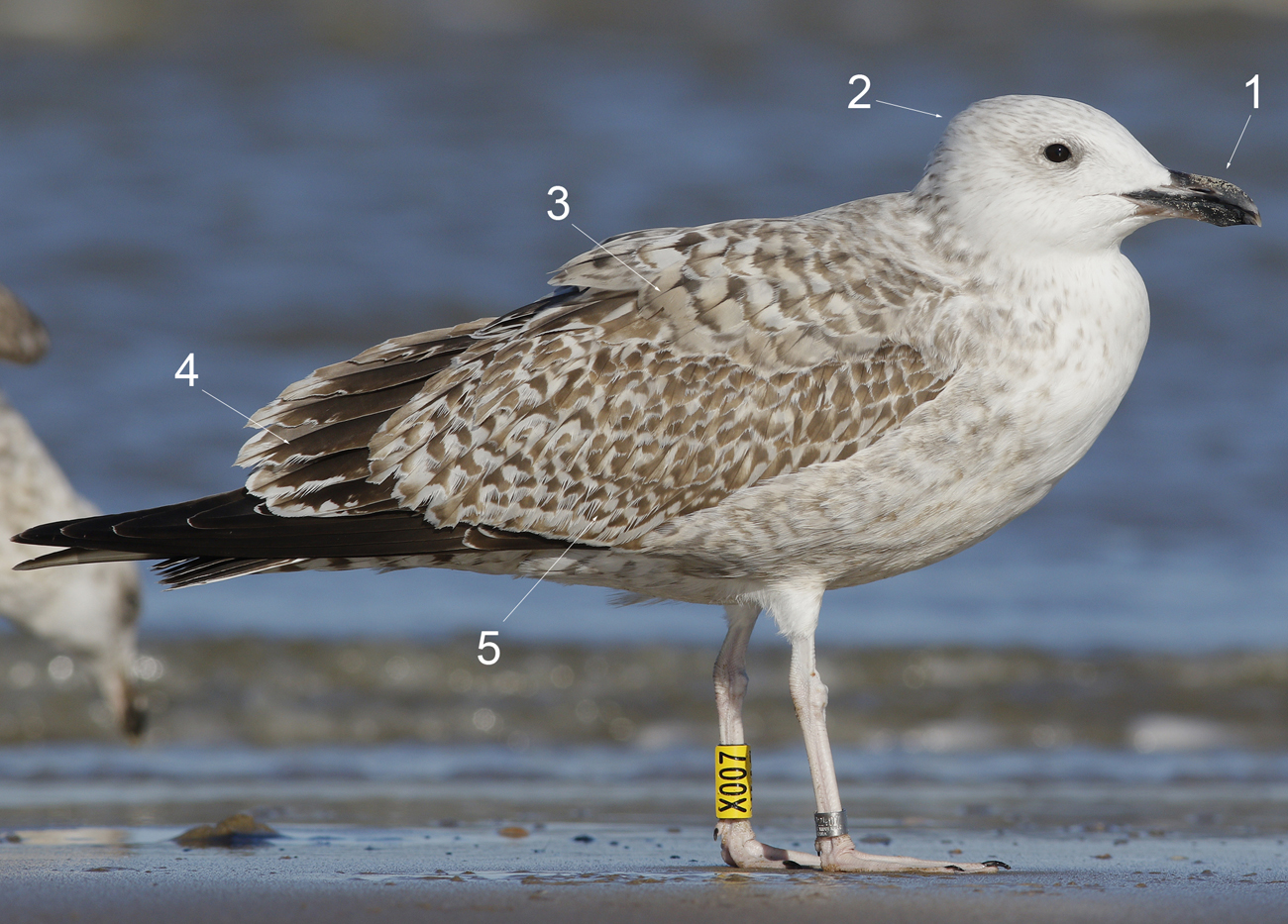
Plate G: Caspian Gull hybrid Y[X007] 1st cycle, October 05 2016, Katwijk. In general more of a Herring Gull than a Caspian Gull by the strong powerful bill showing an obvious gonys angle (1), square shaped head like in Herring Gull, showing obvious streaking (2), late moult in scapulars, the last replaced scapulars again show a bold anchor pattern (3; you rather prefer ill-defined transversal bars or no bars at all-in Caspian Gull), postage stamp pattern on tertials fringes (4) and this pattern repeated on greater coverts (4; ideally, Caspian Gull has smooth straight pale fringes, lacking this type of notching).
Y[X007] was ringed as chick on June 07 2016 in the Laußig mixed colony, eastern Germany (51,34 N 12,38 E).
========
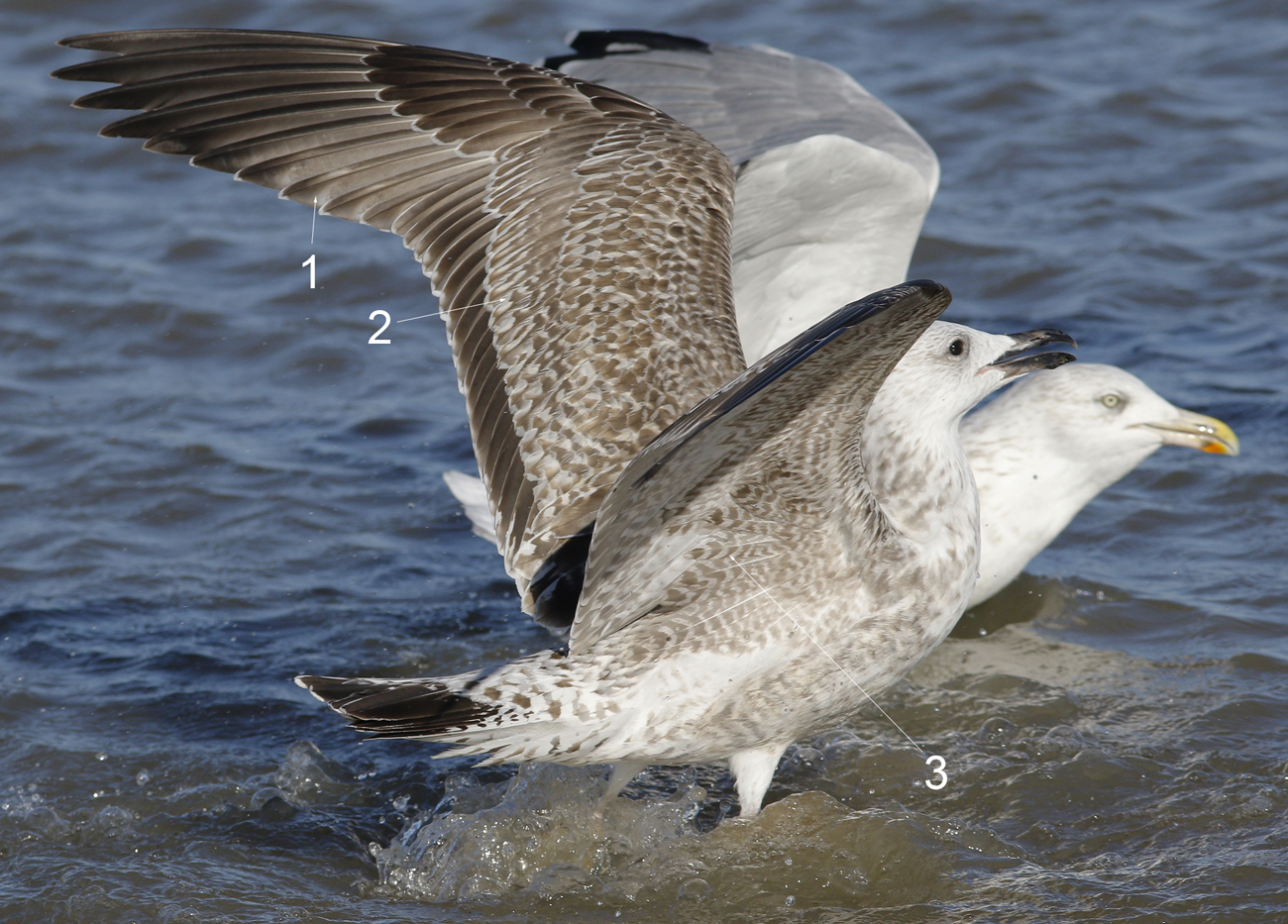
Plate H: again Caspian Gull hybrid Y[X007]. Showing the open wing. Pattern as in Herring Gull with pale lozenges on the outerwebs of the inner primaries (1), postage stamp notching on inner and central greater coverts (2), and much lining on underwing coverts (3; preferably a pale underwing in Caspian Gull). The long call of Y[X007] matched Caspian Gull rather than the present Herring Gulls.
========
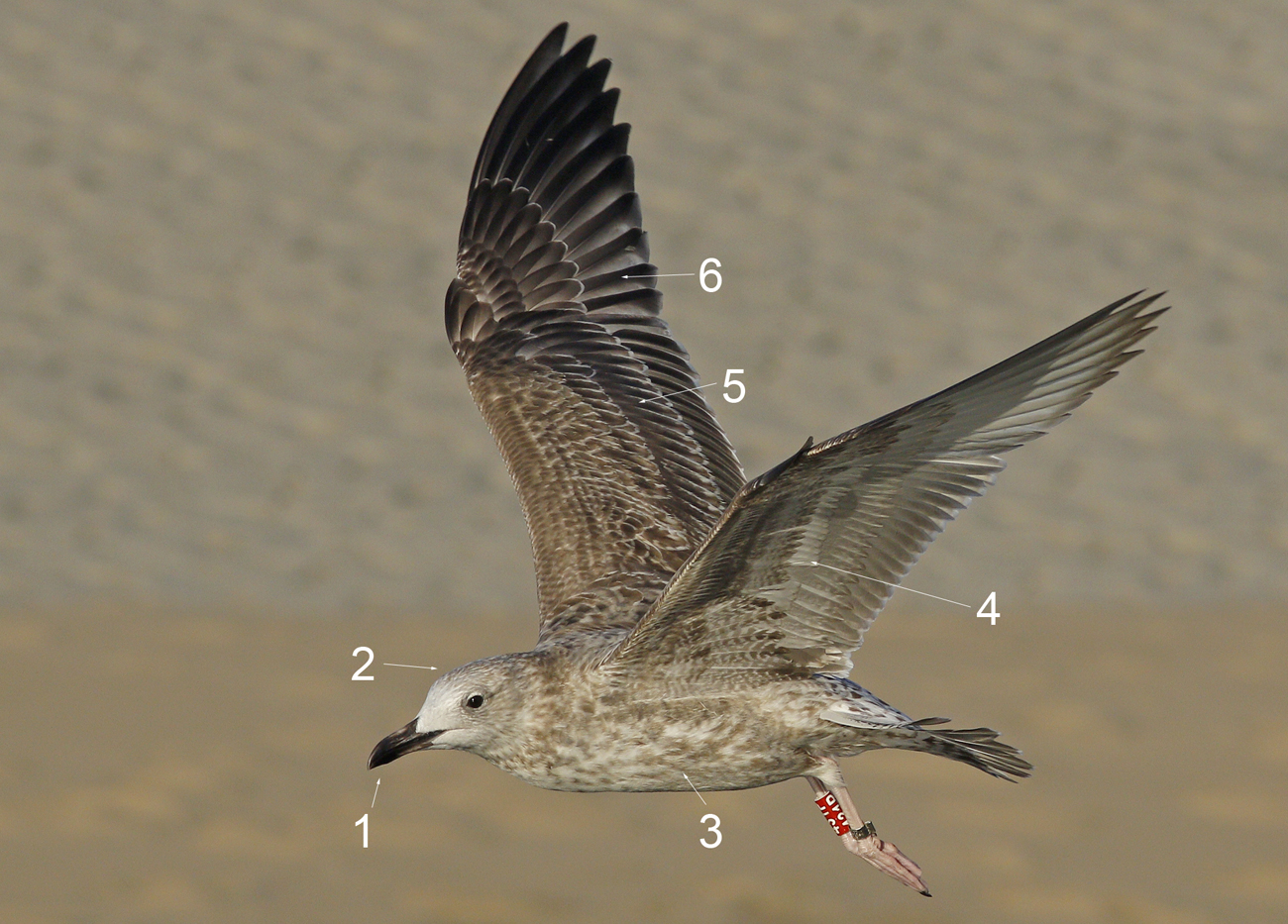
Plate I: Caspian Gull hybrid? R[431P] 1st cycle, September 10 2016, Katwijk. Much resemblance to pure Caspian Gull, including long slender bill (1), pale underwing coverts (4), dark-centred central greater coverts lacking obvious notching (5) and a classic wingtip showing inner primaries with dark outerwebs (6). Slightly odd are the square shaped head with relatively much streaking as in Herring Gull (2) and extensive dark on underparts (3).
R[431P] was ringed as chick on May 26 2016 in the largest mixed Polish colony of Zastow Karczmiski along river Vistula (51,15 N 21,51 E).
========
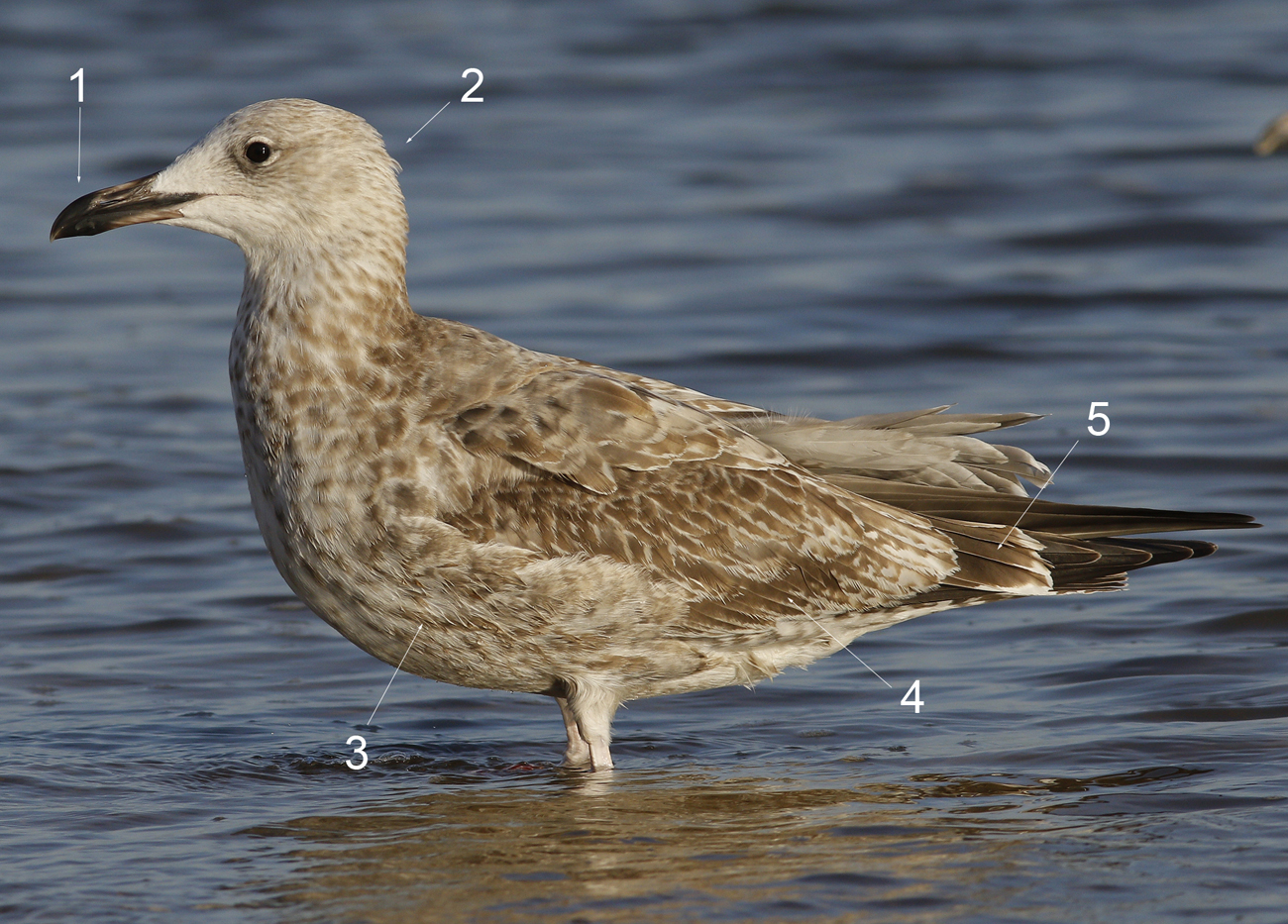
Plate J: again Caspian Gull hybrid? R[431P]. Long and slender bill as in Caspian Gull (1), as are dark central greater coverts lacking obvious postage stamp patterns (4) and ‘smooth straight pattern’ on tertials, lacking notching on the fringes (5). But note the intense head streaking (2) and extensive dark on underparts (3; possibly some correlation for 2 and 3). This bird was first localised on the classic Caspian Gull call, drawing attention before the red ring was noticed.
========
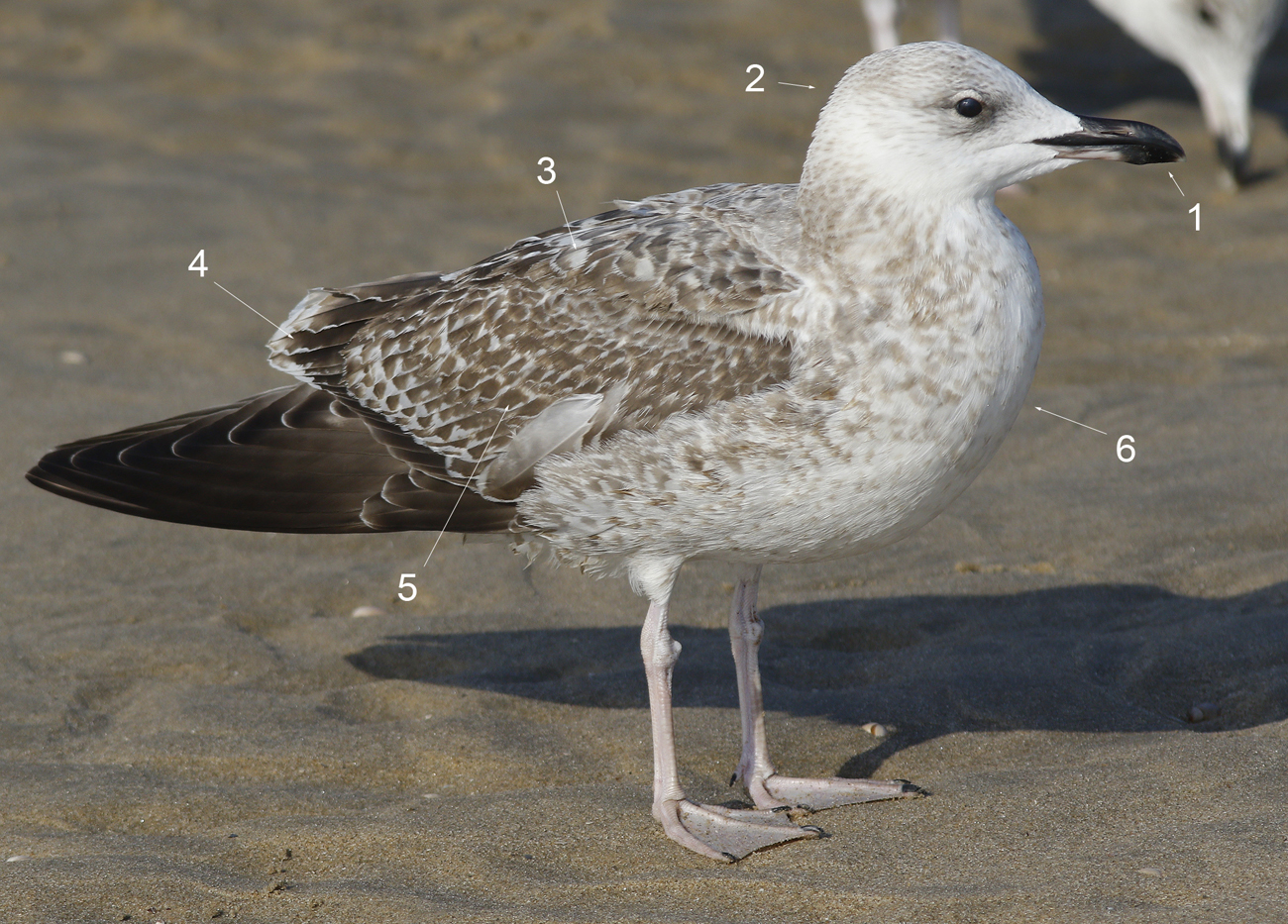
Plate K: Caspian Gull hybrid 1st cycle, October 13 2015, Katwijk. It has strong resemblance to Herring Gull by the bold anchor patterns on scapulars (3; lower scapulars still juvenile), by the notched fringes on tertials (4), and by the mud-brown tone on juvenile wing-coverts (5). However, the contact call strongly pointed to Caspian Gull and bill-shape is a good match too (1; bill without strong gonydeal angle), and it shows the characteristically pale underparts of Caspian Gull (6) with a white head. The primaries are blackish brown without pale tips, which also is in line with Caspian Gull.
========
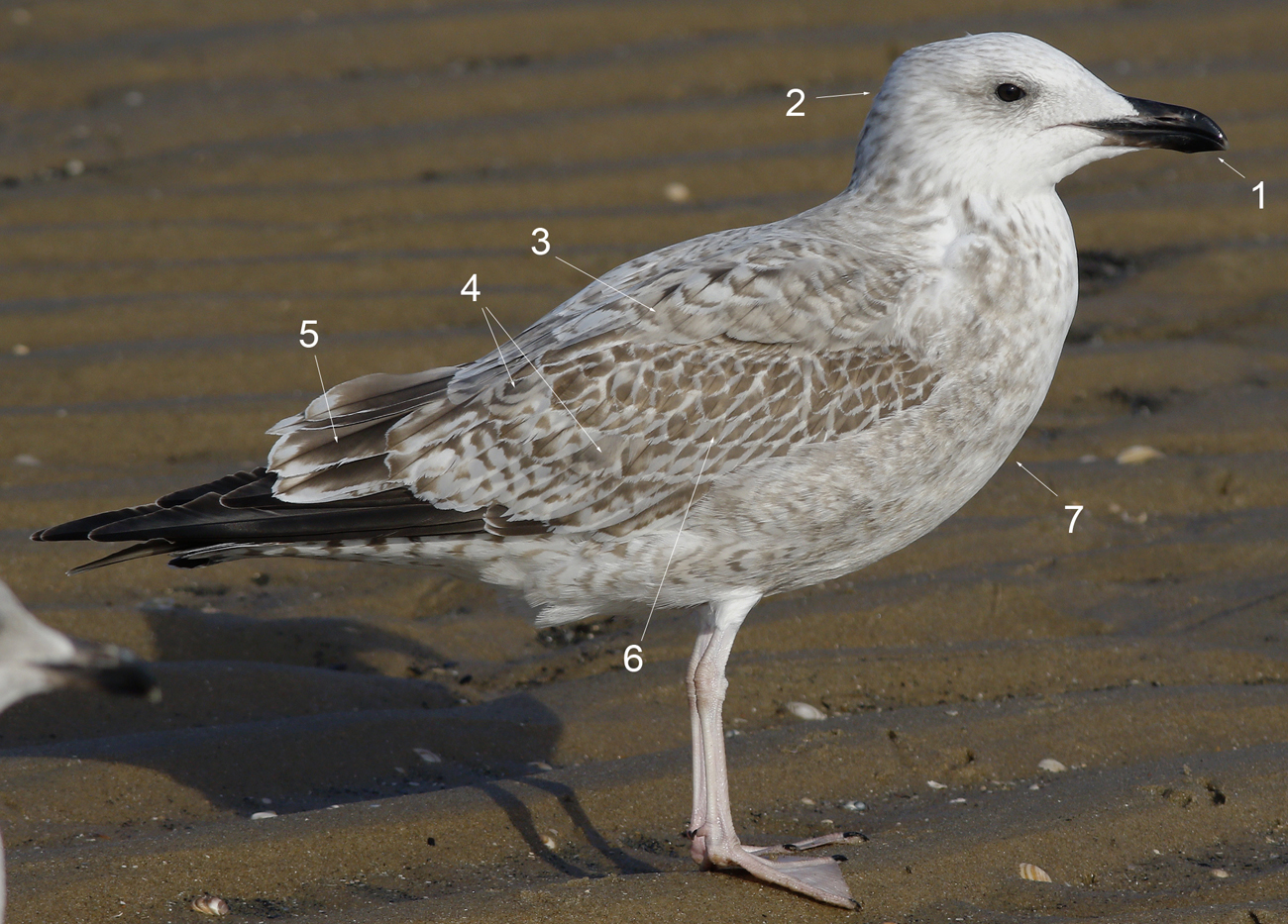
Foto L: Caspian Gull hybrid 1st cycle, October 13 2015, Katwijk. Close match to Caspian Gull as it shows advanced moult with all scapulars replaced (3) and some replaced wing-coverts (4). The tertials show a smooth pattern, lacking notching in the fringes (5), and juvenile coverts have a pale brown tone (6). Odd features are the blunt, high bill (1), the squarish head emphasising the stocky profile (2), and the extensive dark on underparts (7).
========
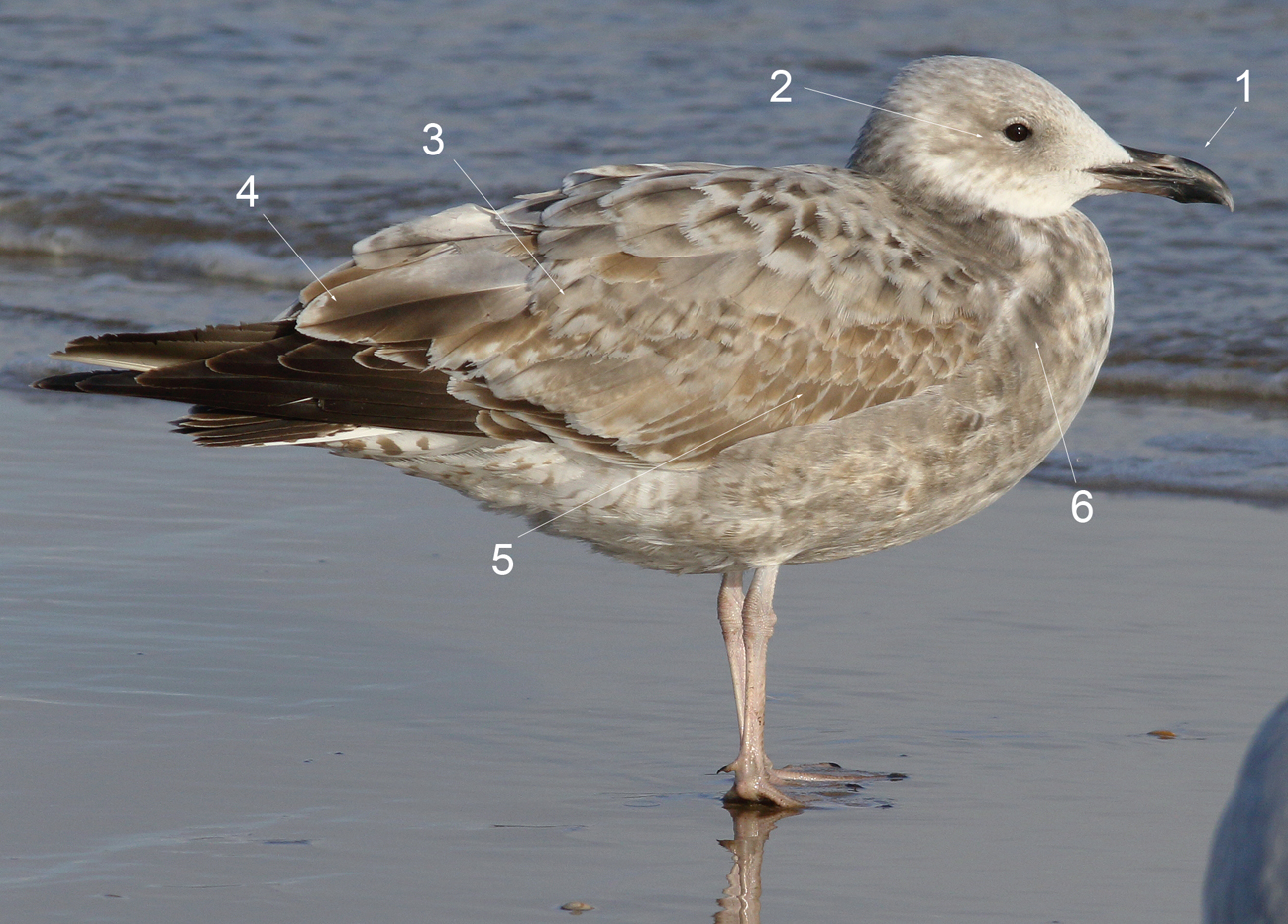
Foto M: Caspian Gull hybrid 1st cycle, November 12 2015, Katwijk. Resemblance to Caspian Gull by the long slender bill (1), replaced inner wing-coverts (3), tertials with ‘smooth pattern’ lacking notching (4), and the rather pale brown juvenile feathers (5). However, the head is extensively dark (2), as are the underparts (6).
========
Foto N: Caspian Gull hybrid G[XZFD] 1st cycle, October 29 2015, Katwijk. Overall a Caspian Gull, but very dark on underparts and breast. Furthermore, the scapular moult is delayed for this species as part of the lower scapulars is still juvenile.
G[XZFD] was ringed as chick on June 09 2015 in the Gräbendorfer See mixed colony, in eastern Germany (51,42 N 14,06 E).
========
Ring readings supported the assumption that a good portion of the East German gulls migrate to Dutch beaches in autumn. These pictures illustrate some problematic birds regarding identification, that we have to deal with. Nowadays, maybe more than ever as intense ringing programmes are combined with increased possession of digital SLR cameras, it is rewarding to check flocks of gulls and document ringed birds. Katwijk beach may contain good numbers of eastern birds, illustrated by a count on October 10 2016: 17 1st cycles, 5 2nd cycles, 3 3rd cycles and one adult Caspian Gull in a total group of 1500 gulls present that day.
One month later, November 2016, was even better with over 50 Caspians at Katwijk, in a larger group of 2000 birds present, just after a cold front hit Eastern Europe and pushed birds westwards.
Pictures: Mars Muusse
Literature:
Beran V., G. Neubauer & M. Zagalska-Neubauer, 2010. First proven case of a backcross hybrid between the Herring Gull (Larus argentatus) and the Caspian Gull (Larus cachinnans) in the Czech Republic. Sylvia 46.
Neubauer, G., M. Zagalska-Neuhauer, R. Gwiazda, M. Faber, D. Bukaciriski, J. Betleja & R Chylarecki, 2006. Breeding large gulls in Poland: distribution, numbers, trends and hybridisation. Vogelwelt 127: 11-22.
Van Dijk K., 2013. Pontische Meeuwen Larus cachinnans langs de Nederlandse kust. In press voor Sula; online version Sept 2015.

